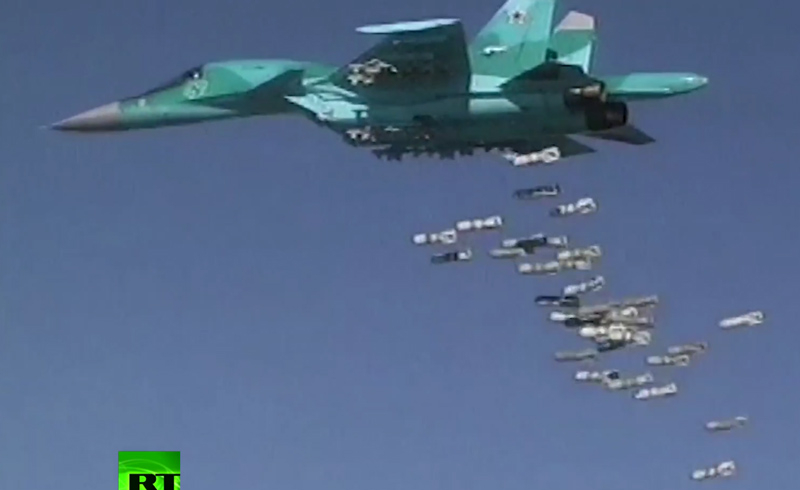Iran’s Supreme National Security Council admitted on August 16 that Tehran is permitting Russian military aircraft to stage operations against Syrian rebels from an Iranian airbase.[1] Satellite photography previously confirmed Russian military aircraft on the tarmac of Iran’s Shahid Nojeh Airfield in 2015.
This is the first time, however, that Tehran is publicly confirming that it is allowing advanced Russian long-range bombers to use its main air base in Hamadan Province.
Previously, Russia’s aircraft ran bombing missions from Russian airbases in the Caspian Region and from Syria’s Latakia/Hmyemim (Naval/Air) complex. While the Hmyemim Airfield was adequate for Russian fighter-bomber aircraft such as the SU-24 (Fencer), the SU-34 (Fullback) and Moscow’s attack helicopters, to conduct missions inside Syria, the runway is not long enough to accommodate heavier types of bombers. The runway at Hamadan is 15,000 feet long, permitting Russia’s TU-160 (Blackjack), TU-22 (Backfire), and older Bear (TU-95) long-range bombers to stage operations.[2]
The Kremlin no doubt requested access to Iranian military facilities for similar reasons that the United States sought permission from Turkey to use its base at Incirlik: The bombers would be closer to their targets, which are presumably terrorist formations amidst the anti-Assad rebel groups. Flying Russian aircraft to Syria from Iran’s Hamadan airfield, rather than from Russia, cuts the distance by approximately 1000 miles. With the lessened amount of fuel needed, there is “room” for heavier payloads to use on the targets. Additionally, Hamadan airfield features several hangars for aircraft repair and bunkers for pilot rest and recreation.

A Russian bomber operating from Iran’s Hamadan Airbase drops bombs over Syria, August 17, 2016. (Image source: RT video screenshot) |
Geopolitical reasons that are associated with this deepening Russian-Iranian cooperation include increased Iranian casualties and recent rebel gains, both causes for concern to Iran’s high command. In addition, Iran’s deepening military cooperation with Russia serves as a hedge in the Iranian calculus against any unilateral Israeli attack on its nuclear facilities during an interregnum between the Obama era and the inauguration of the next U.S. president in January 2017.
Moscow probably enjoys filling a vacuum created by U.S. refusal to be drawn too deeply into Syria’s civil war. Additionally, Russia’s air force is profiting by targeting training under wartime conditions, with little loss of personnel and equipment. Russia also most likely hopes to become the main arms supplier to Iran. Finally, both Russia and Iran view the possibility of a Sunni extremist regime in Syria as not in their interest. Russia already fears the return of thousands of Muslims who traveled from the North Caucasus and Central Asia to fight with the Islamic State in Iraq and Syria.
There is, however a downside for the Iranian regime. Russia has had a long predatory interest in Iran. In the late 19th and first half of the 20th centuries, Russia cooperated with Great Britain in dividing Iran into spheres of interest. Soviet Russia, after World War II, even occupied northern Iran for a brief period. Tehran’s granting the Kremlin access to its airfields contradicts Imam Khomeini’s ideological formula: “Neither East nor West.” Khomeini was contemptuous of both the United States and the Soviet Union. He promised that Iran would stand on its own and not submit to the will of either superpower.
The Iranian regime’s internal opposition might exploit this concession to a foreign power in a similar manner as did the Islamists against the late Shah. The Islamic revolutionaries accused the Shah of having capitulated to America by allowing American servicemen special legal status, not being subject to Iranian law. The revolutionaries won Iranian nationalists to their side by these attacks on the Shah’s alleged lack of patriotism.
Dr. Lawrence A. Franklin was the Iran Desk Officer for Secretary of Defense Rumsfeld. He also served on active duty with the U.S. Army and as a Colonel in the Air Force Reserve, where he was a Military Attaché at the U.S. Embassy in Israel.
[1] Secretary of Iran’s Supreme National Security Council Ali Shamkhani confirms the story in Iranian media.
[2] Numerous RT Russian Videos showing Russian bombing runs by various long range bombers inside Syria from Russian airbases like Lipetsk Airfield in Russia and from other bases including Hmyemim in Syria. See Open source material on NATO names of Russian bombers and use of Iran’s airbase in Hamadan Province.
























